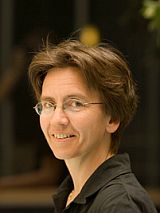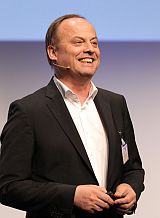Invited Speakers

Observing the dark: cosmological constraints on gravity theory
Tamara Davis
Professor Cosmology & Astrophysics
Centre of Excellence in All-sky Astrophysics, AustraliaIn this talk I review the many varied ways we have tested the laws of gravity using cosmological observations. From supernovae, cosmic microwave background, growth of structure, galaxy clustering, gravitational lensing, and more, we now have very strong constraints on the properties of our theory of gravity and any quantum (or other) improvements we may want to make to it. I’ll review the latest results of a wide range of cosmological probes, and show what we expect to be able to do with the next generation of surveys.

In silico Neuroscience – an integrative approach
Felix Schürmann
Co-director of the Blue Brain Project
EPFL, SwitzerlandMany areas of science and engineering have adopted simulation-based research as a novel tool for discovery and insight. The sustained performance growth in supercomputering technology allows for ever more detailed models, rendering supercomputing a viable tool for biology. However, the heterogeneity of neural systems poses particular challenges: the data is multi-modal, multi-scale and often times incomplete; intricate workflows are required for model generation; mathematical formulations are volatile; and due to heterogeneity requirements memory and compute power are demanding. At the same time, neurobiology has potentially a lot to gain: systematically accounting for the data and bringing it together in a unifying computer model provides an integration strategy capable of overcoming the fragmentation of data and identifying gaps in our knowledge. Attempting this ultimate integration is revealing novel design principles of the brain. These principles are in turn helping to predictively fill gaps in data and knowledge. As a proof of concept, the Blue Brain Project built a facility comprised of many key technologies and workflows. We use this facility to build and simulate a unifying model of the neocortical microcircuit of young rats.

Searching for the Quantum Dynamics of Gravity
Renate Loll
Professor Theoretical Physics (Quantum Gravity)
IMAPP at Radboud University, NetherlandsExactly 100 years after Einstein formulated the dynamical laws for the gravitational forces in his famous theory of General Relativity, we are still searching for their quantum origins, to be described by a theory of Quantum Gravity. What are the microscopic degrees of freedom of gravity, and how do they interact at the ultra-short Planck scale of 10 -35 m to bring about familiar gravitational phenomena on macroscopic, classical scales? Which new phenomena does Quantum Gravity predict?
Constructing quantum gravity by standard, perturbative methods has long been known to lead to incurable divergences, rendering it meaningless at the Planck scale. My collaborators and I tackle the problem nonperturbatively, using a minimalist set of ingredients and assumptions, without supersymmetry, extra dimensions or extended objects like strings. Using the equivalence between gravitational forces and spacetime curvature, we model microscopic gravitational interactions in terms of quantum fluctuating, triangulated curved spacetime geometries. The triangular building blocks form part of an intermediate regularization, and are eventually "shrunk away" in a continuum limit.
The great difficulty is to come up with a formulation of this type that is well-defined computationally, i.e. leads to finite, unambiguous results after renormalization, and, by way of a consistency check, can be shown to reproduce well-known results of classical general relativity on macroscopic scales. This is precisely what has been achieved in Causal Dynamical Triangulations (CDT), a promising candidate theory for quantum gravity. Key to its success has been the availability of powerful numerical methods. Using Monte Carlo simulations, we have extracted some remarkable, quantitative results, which help us understand the highly complex dynamics of spacetime at the Planck scale. I will briefly describe some of these developments, as well as work in progress and future ambitions.
Physical Models of Brain Circuits
Karlheinz Meier
Leader Neuromorphic Computing Platform of the Human Brain Project
University of Heidelberg, GermanyThe brain is a complex network of 1011 nodes and 1015 synaptic connections. It evolves in constant interaction with the environment on timescales from milliseconds to years. Numerical simulations of this system provide some insights but are severely constrained by prohibitive energy consumption and simulation times. In 1982, Feynman postulated a simulation, in which the number of computer elements required to simulate a large physical system is only proportional to the space-time- volume of the physical system. Similar to today’s quantum emulators neuromorphic systems follow this path by building physical models of brain circuits under user control rather than solving differential equations numerically. The lecture will introduce this experimental approach and show some results. Special emphasis is given to the representation of information by probability distributions stored in networks of spiking neurons from which stochastic samples are drawn during a decision process.

Quantizing Space-Time in Quantum Complexity Theory
Barbara Terhal
Professor Theoretical Physics (Condensed Matter)
Institute for Quantum Information at RWTH Aachen University, GermanyQuantum complexity theory is a field of research which aims at understanding the computational power of quantum computers. In this field of study we build formal models of quantum (or classical) computations and exhibit mappings and equivalences between such models. A central construction in quantum complexity theory is a mapping from quantum dynamics, captured by a quantum circuit, onto a circuit Hamiltonian whose ground-space fully encodes the dynamics, originally formulated by Feynman. In the recently developed space-time construction this mapping is achieved by endowing each particle in the computation with a quantized clock register on which the circuit Hamiltonian acts coherently. I will discuss features of the space-time construction which do not only make it a useful tool in quantum complexity theory but also an elegant model of the quantum physical world.

Our quest to unveil the nature of dark energy
Alessandra Silvestri
Fellow of the Delta Institute for Theoretical Physics
Lorentz Institute at Leiden University, NetherlandsIt is now an exceptional time for modern cosmology, when we can observe the universe with high precision and connect cosmological measurements with theory. With the evolution of the universe spanning a vast range of energies and scales, cosmological observables can shed light on virtually any particle physics model and any theory of gravity. The excitement about the advances of observational cosmology is accompanied by the awareness that we face some major challenges. While the standard cosmological model provides a very good fit to existing data, it relies on a universe of which we know only 4% of the content. Ongoing and future cosmological surveys will provide us with a wealth of high precision cosmological and astrophysical data that will enable us to unlock some of the mysteries that we are currently facing. I will discuss theoretical issues involved in finding an optimal framework to study deviations from General Relativity on cosmological scales, giving an overview of recent progress.
